
Candida Martinelli's Italophile Site

Main
Page This family-friendly site celebrates Italian culture for the enjoyment of children and
adults. Site-Overview
Below:
Unique photochrome Images of Venice circa 1890
Venice was the world's first corporation. From very
early on, the city-state was run by a Board of Governors, headed by a
Director, all of whom presided over a company administrative staff, in a
company headquarters, with subsidiary offices in their area of business
interests, and those working for the company received salaries and
shares in her profits. You can replace all the company terms with Venetian ones, but the
meaning is the same. Here is an interesting quote from The Economist: explaining
how the move from an "inclusive economic structure", which allows for
shared wealth and upward mobility, to an "exclusive economic structure",
which locks wealth into the hands of an oligarchic elite and
dooms a society to instability and eventual poverty, contributed to
Venice's economic downfall. "...Venice provides a cautionary tale. Upward mobility drove
the city-state's wealth and power. Its innovative commenda, a
partnership in which capital-poor sailors and rich Venetians shared the
profits from voyages, allowed those of modest background to rise through
the ranks. This fluidity threatened established wealth, however,
From the later 13th century the ducal council began restricting
political and economic rights, banning the commenda and nationalising
trade. By 1500, with a stagnant economy and falling population,
Venice's descent from great power was well under way."
Courtesy of GoogleEarth.
Note the Grand Canal snaking
through from the train station, on the left, to Saint Mark's Square and
the Doge's Palace at the right end of the canal.
The large pool of water toward the right end of Venice is The Arsenal, a
huge boat-ship building facility that produced, assembly-line style, the
ships that made Venice a naval power and trading-rich Republic.
Giudecca is the island(s) at the bottom of the image.
San Michele, the cemetery island, sits above Venice.
Murano, the glass-making island, is above San Michele.
The wondrous things that can be made of glass...
Only seeing is believing. Until you have a chance to visit Murano
island and its many shops and the foundries in operation, I have some
images you can enjoy on my Murano Page. Many of the small glass
tourist souvenirs are now made in China.
Yes, this is made of glass! As is this...
There are other islands in the Venetian lagoon. About 40
minutes from Venice by boat bus (vaporetto) is the island of Burano.
From my experience, there comes a moment when visiting Venice, that
the crumbling decay of the once glorious buildings, and the graffiti on
walls from the 1200s, makes me depressed. If that happens to you, I suggest a trip to Burano. It is
light, airy, colorful and beautifully tended. The people are, generally speaking, ruder to tourist than the ones in
Venice. If they can make money from you, they are a bit better
than average.
It is a living community of fishermen and women. Once famous
for the lace-makers, it is now just a nice side trip from Venice.
I have a page dedicated to Burano.
The Venetian school of art overflows with artists and their
masterpieces. To help prepare for a visit, visit my pages with short, illustrated biographies of these
artists. You can see works by these artists in the Accademia
Galleries in Venice, and in many of the hundred or more churches in
Venice.
If modern art is more to
your liking, you must visit the Guggenheim Museum in
Venice. To read about Peggy Guggenheim and her modern art
museum in Venice, click on the image to go through to my Art
page. And the Biennale, the world's top modern art event, happens every two
years in Venice. Countries sponsor displays of the work by their
top artists.
Venice's famous 'Biennale', or arts
program,
includes the Venice Film Festival, among dance, music, art ...
exhibits. Canaletto's view of the main square of Venice. You can visit my Venice
Art - Canaletto page for more images and info. The Venetian
palace, now a lovely, human-sized museum, Ca' Rezzonico, has two
Canalettos in their collection. Here is an image of the canal-level entrance to the Grand Canal
palace Ca' Rezzonico.
And the main staircase of Ca' Rezzonico.
And a view from the top floor, looking out on the garden in the back
(to the right), and the view over the rooftops and rio (a small
canal).
Scuola Grande di San Rocco's
wonderful website,
including a virtual tour. Worth a visit! And in Venice the
visit to the lavishly decorated meeting hall is sure to leave you in
shock, so plan to take a break after the visit so you can recover. Venice35.com a site that lists
accommodations in Venice that cost about 35 pp/pn
Home Away
Holiday Rentals - Owner direct rentals, no middleman
I used this recently for a trip to Venice, and it was wonderful.
Living in an apartment makes you have a greater appreciation for Venice,
and the daily trials and tribulations of her permanent residents.
And renting directly from the owner cuts out the agents, who generally
provide terrible service, and who tend not to care if you complain or
have problems, because they are sure they will find other suckers.
Owners care more about return visits, and bad reviews on the rental site
website.
Escapio.com
offers a wide selection of boutique hotels in Italy. You
can search the selection by price, popularity, region, city, and even by
hotel type (i.e. boutique, historic, gourmet, family, design, luxury,
romantic, spa, nature and many, many more) and features such as internet,
city, sea, pool, spa, and many more. There is even an option to
check for those hotels offering the best discounted prices. I link
here to their
Veneto Hotels.
For more on Venice's sights, try this
Venice Desitination Guide. The service also offers wonderful
Destination guides for hundreds of Italian cities, including:
Views on Venice offer
apartments for rent in Venice, and as a bonus, provide this
useful map, via Google Maps, with their apartments marked, along
with supermarkets, some shops and many restaurants.
Try
Truly Venice for
exclusive apartments for short and long-term rental. They offer apartments in four categories:
Romantic, Contemporary, Comfort, and Classic (my favorite). They offer
other tourist services like yacht hire, catering and private guides.
This preface is to the chapter on Venice from Henry
James's 1909 book "Italian Hours". "Venice. It
is a great pleasure to write the word; but I am not sure there is not a
certain impudence in pretending to add anything to it. Venice has been
painted and described many thousands of times, and of all the cities of
the world is the easiest to visit without going there. Open the first
book and you will find a rhapsody about it; step into the first
picture-dealer's and you will find three or four high-coloured "views"
of it. There is
notoriously nothing more to be said on the subject. Every one has
been there, and every one has brought back a collection of photographs.
There is as
little mystery about the Grand Canal as about our local thoroughfare,
and the name of St. Mark is as familiar as the postman's ring.
It is not
forbidden, however, to speak of familiar things, and I hold that for the
true Venice-lover Venice is always in order. There is nothing
new to be said about her certainly, but the old is better than any
novelty. It would be a sad day indeed when there should be
something new to say. I write these
lines with the full consciousness of having no information whatever to
offer. I do not pretend to enlighten the reader; I pretend only to
give a fillip to his memory; and I hold any writer sufficiently
justified who is himself in love with his theme." There are classic books about Venice available for free on the
Internet's most wonderful source for classic books: Project
Gutenberg. These are links to the download pages for these FREE books. They are
available in various formats, such as EPUB, Kindle, plain text, HTML,
and others. But there is also a button on the page, that you can click on if you
wish to just read the book online. But I suggest you read the
books online by selecting the HTML version. That way you can see
all the book's images, and the text chapters are hyperlinked. John Ruskin's authoritative classic: Henry James's travelogue which includes Venice: Italian Hours
(English) (as Author) Casanova's Memoirs with some parts in Venice:
Complete Memoirs of Jacques Casanova de Seingalt E. V. Lucas's travelogue: Artist Albrecht Dürer's memoirs part in Venice:
Memoirs of Journeys to Venice and the Low Countries Mrs. Lawrence Turnbull's historical romance novel
set in 1570s Venice, written in 1900, which gives a good
impression of what it might have been like to live in the Venetian
Republic. But the book can be a hard slog when the battle between Venice and
the Popes begins: F. Marion Crawford's romance novel set in 1450s Venice and Murano was
written in 1901. The author weaves a very entertaining historical
romance novel from historical fact and imagination. Zorzi, a
famous Dalmation-Venetian glassmaker is the male love interest.
Marietta, the daughter of Barovier, a famous Venetian glassmaker, is the
willing object of Zorzi's love. I highly recommend the book to
lovers of historical romances.
Marietta (Maid of Venice) If you like to read fiction set in contemporary Venice, and you are a fan of
classic murder mysteries, I can recommend Edward Sklepowich's series
featuring his sleuth "Urbino Macintyre".
And there is a wonderful historical mystery series set in Venice in the
mid-late1700s, by Beverle Graves Myers: the Tito Amato Series.
You can read more about these two series, and learn of others, on my
Mysteries set in Italy page.
Venice is called the Serenissima, or the Most Serine, because
of it's serene beauty, and for the quiet atmosphere created by waterways
running through the town rather than roads, for the boats instead of
cars, and for the feeling of stepping back in time. Some call it the Queen
or Jewel or Pearl of the Adriatic.
I prefer to call it magical,
especially when the fog is blurring her rougher edges, and mist has
given every stone a reflective sheen. The geographic isolation of Venice has contributed to the unique
character and dialect of Venetians. They are famously soft-spoken,
sweet-tempered and mild-mannered, in an Italy more known for it's
extraversion. The spoken dialect sounds like a whispered song;
very sensual. Although that has changed in the last two decades, since mass tourism
has displaced many local residents, and many of those who remain have
become jaded, surly and at times outright rude. And the illegal
immigrants who sell on the street corners can be frighteningly
aggressive, and the hawkers outside the restaurants can be irritatingly.
Remember this... No books, videos, photos or words can adequately
prepare anyone for a trip to Venice. Once on the boat-bus, il vaporetto, cruising down
the Grand Canal, the unique reality that is Venice hits full force.
The size, beauty, water-streets, crumbling extravagance... The result is
a stupor, the early phase of Stendhal Syndrome, the illness
caused by an over-indulgence in magnificent art and culture.
Rialto Bridge Stendhal Syndrome, in mild to severe form, follows all visitors to
Venice during their stay there. Every turn of a corner presents to
the eye something new, fascinating, beautiful, evocative, things never
before imagined.
The cumulative effect of all this, is a numbness of the brain.
One finds one's senses shutting down. Suddenly mundane things push
themselves into the brain. While standing before the Baroque
exuberance of St. Moses Church, for example, you can hear tourists
talking about gossip from back home. It is a defense mechanism.
When you find yourself doing that, it is best to return to your hotel
or apartment to rest and recover, before setting out again to
make more beautiful discoveries.
Here is nice freebie. This is a history of Venice, and a guide to
all the districts of Venice. The book is
available to download
via Gutenberg Press, in various formats including Kindle and EPub.
You and also
consult it online in the HTML version. There are no cars or busses in Venice. Not even bicycles are
allowed. Transport is via foot or via boat. Take comfortable
walking shoes! I have seen too many silly women wearing high
heels or ballerina slippers without any foot support or padding.
That is just asking for trouble after a few hours roaming around on
Venice's stone paving.
Vaporetto - Bus-boat Actually, take several pairs of comfortable walking shoes with you.
You will want to alternate them. And some soft inserts are a big
help against the pounding your feet will take from the cobblestones and
stone slabs. Also bandages, plasters, salves... To visit the most in the shortest amount of time, it is a good idea
to use the boat-busses, vaporetti. There are several passes
available that cover everything from 12 hours to a week. A single
trip is 7 Euros. They are expensive and crowded, and the staff
treat you with contempt, so if you have the money, hire a taxi, and if
you have lots of money, hire a boat for your trip.
Inside the prow of a vaporetto Check your plans, see which vaporetto pass can save you the most money, then you
can purchase the tickets/passes at the Tobacconist shops throughout
Venice, or from the machines situated at the larger vaporetto
stops, or at manned ticket booths at some of the stops. Buy a good Venice map, and you will find all the bus-stops indicated,
and the bus-lines. You can use the vaporetti to around Venice,
Giudecca, the Lido, to the cemetery, Murano, Burano and other islands.
A vaporetto (bus) stop, indicated by the yellow bands,
and the name of the stop There are usually two ramps: one for disembarking
passengers, and one for boarding passengers. All the disembarking
passengers are given right-of-way. Then the boarding passengers
are allowed on. Be ready for some pushing, falling and nasty things said
by the Italians about everyone, thinking that like so many of them, no
one speaks another language than their mother-tongue. In fact, you have will have nasty stuff said about you,
or about people around you, sometime at many times during your visit to
Venice. The general level of courtesy is very low these days.
Some shout in your face insults, especially the teenaged boys.
Older men have been seen making catcalls, calling attractive women
whores. And the middle ages of men have been heard saying cruel
things about foreign women's heights, hair, clothes, weight, sexual
preference, partners, etc. What is behind all this nastiness is something for a
shrink to figure out, or a sociologist. Resentment, a sense of
inferiority, or basic cruelty? Whatever it is, it can ruin a trip
to Venice. Maybe that is their intention? Mass tourism has
made the phenomenon more pronounced. Just a warning...
Rialto's vaporetto stop on the left
Here is the same stop from the other perspective, with
the Rialto Bridge, lined with shops, in view behind boat moorings You have to put your vaporatto ticket/pass before a time-clock
before boarding. It registers the time and route automatically,
and if you watch the machine's face closely, you can see when you pass
will expire, if it is a time-pass.
A colleague from Venice once confided in me the four things that most
worry Venetians. This was back before the EU forced Venice to
allow the free purchase of property, and to no longer restrict sales to
locals or children of locals.
Doges Palace with the bell-tower behind Today, many Venetian property owners have sold up,
others are selling up, at prices that rival New York City. And
like New York City, Venice is home to the super-rich, the rich, a small
middle-class, and many poor. City workers cannot afford to buy
property in Venice, so they live outside the city and commute to work. But unlike New York City, Venice is home to no other
major business but tourism. For this reason, it is, in reality, a
dying city. It is an amusement, or historical park for the world's
tourists. To be honest, the administrators of the city could learn
a lot from Disneyland and the other amusement park management companies,
about how to make the tourist's visit a success. Instead, the city
enchants, but the city administration, the public workers, the services,
and the residents disappoint, leading to millions of blog reports of all
the negatives encountered on the expensive visit to Venice.
There are too many cases to mention here of the city arranging something
so that the tourist has to pay more, or for something not necessary,
rather than offering helpful information or a useful service. The
impression remains with many visitors of having been ripped-off, abused,
mistreated. La Fenice is the town's famous opera house
and performance hall.
Their website is full
of history, concert schedules, a shop and photos. It is very
difficult to navigate and to understand. The prices are very
expensive and many of the seats do not even have a clear view of the
stage. You can see the theatre when there are no shows, as a tour.
Check at the theatre for the times and prices. Two images from opening night at La Fenice in
December 2003. La Fenice
burned down in 1996 but has recently risen from the ashes. To
fully understand how devastating the fire was to Venice and her
citizens: The Antico Martini Restaurant in Venice one of the
many famous restaurants that serve food in glorious
surroundings, but for a deep wallet. This one has been around
since 1720. It is right next to the entrance to the Teatro Fenice. They have a website with photos, history,
menus, recipes and famous person's guestbook. The Antico Martini Restaurant today and in the 1700's Next to the theatre, to one side of the Antico Martino Restaurant,
there is this lovely courtyard before a palace divided into several
apartments. On the ground floor is a wine-bar.
The typically Venetian boat, the gondola, made of lacquered wood, has varied little over the
centuries. They are used everyday in Venice to transport not just
tourists. There are gondola traghetti, boats that cross over the Grand
Canal at various points, that cost you a Euro or so. They are indicated on good
maps of Venice and by signs and street names, such as Calle del
tragehetto.
For a very, very long time, an earlier wooden version of the Rialto
Bridge was the only bridge across the Grand Canal. So the gondola
traghetto would
carry people with their shopping, briefcases, school bags... from one
side to the other, all day long.
Here is a gondolier using an age-old technique to cast
off from a wall so as to make the tight turn up ahead.
Venice is famous for it's celebration of Carnevale, and for
the carnival masks, many of which are made in China these days.
I've a page dedicated to Venice's Carnival,
with lots of beautiful images, the characters you might see roaming the
streets, and some background. Carnevale began as one of those wild festivals that
give periodic relief to citizens of repressive societies. Masked
Venetians could make fools of themselves and their partners without
paying the consequences only that night of the year. The wild
nature of the celebrations wore out even the ever-ready-for-an-adventure
English poet Byron. He left Venice after a wild Carnevale,
too exhausted to remain.
Venetian artists celebrate the Commedia dell'arte characters (masks) to
this day, mainly because they are popular costumes for Carnival.
Two shop windows photographed in Venice in 2011
Carnival died out eventually, but was revived in the 1980s. Here is an
official site with information on the upcoming Carnival
celebrations.
If you like living history, click on either image
above to read my page with excepts from a book written
in 1866 about life in Venice, by the U. S. Consul, William Dean Howells.
If you've never
been to Venice, take this virtual
photo tour to get an idea of what you're missing. It is an
uniquely beautiful town that words alone cannot describe. If you
want to see Venice right now, this moment, visit this WebCam.
If you've been to Venice, and were upset that you couldn't see
everything you wanted to see, a common occurrence, try these sites.
If you wish to have others plan your daily tours of Venice, you might
try this group. Venicescapes.org's
themed guided walking tours. Their site describes in great detail
the tours, thus describing much of Venice's history. Click on the
image above to go directly to their list of walking tours.
If you want to plan your own tours, here are some site tips. But I
recommend you purchase some good books that break the city down by area,
pointing out the sights along the way. It is nicest to just pick
an area and ramble along the alleyways, stopping now and then to take in
some special attraction.
There is a lot of information available from other tourists to Venice on
travel sites, in many languages. They are a priceless source of
information, so use them before you go to Venice. Do not expect to
get great information in Venice. Do your research. Many
things in the city are set up to make you pay for things you don't need.
In the case of Venice, traveler beware!
For example, the cheap RyanAir flights into Treviso airport require a
bus trip to Venice after your flight. RyanAir sells bus tickets on
the flight. But their bus takes nearly 2 hours to reach Venice.
The private company, Barzi, offers a bus service at the same price, that
takes 40 minutes.
And the Barzi bus stops at the Tronchetto Island parking garage.
The city has put up a huge sign outside the garage that says the way to
Venice from Tranchetto is via the people mover, a tram that goes to
Piazzale Rome, from where you have to fight the crowds to get a
boat-bus, vaporetto, to get around Venice.
But if you walk 100 meters down the Tronchetto quay, from the Barzi bus
stop, you can board a Venice boat-bus, a vaporetto, that can take you
directly into Venice, to your hotel, or apartment, or to St. Mark's
Square. The city has even locked the gate to the nearer vaporetto
stop that is next to the people mover, the Tronchetto Mercato, so you
feel you have to take the silly tram. The boat-bus stop,
Tronchetto, is not visible from the bus stop. You have to know it
is 100 meters down the quay.
The
Ville Venete & Castelli site has information on all the Villas and
gardens in the Venice area. The
Jewish
Ghetto is a major attraction. I recommend before you visit the real thing,
to visit this
Virtual
History Tour of the Ghetto, the world's oldest. And here is
the link to the Ghetto Museum. Fodor's has put their
guide to Venice on-line, covering accommodation, restaurants, cafes and
bars, and shops and services. Whether you are going to Venice for Carnevale, or at another
time of year, this Things To Do In Venice site offers a great City
Guide to get your plans started.
These extraordinary images come from the
Old Picture site. It is
a wonderful place to browse the past. If you are an educator, it
is a fantastic resource for lessons, bringing the past to life in a way
mere words or paintings cannot. This is the
link to their
Italy category, and this link
is to their home page. Venice Courtyard
The aquifer wells, visible in almost all squares (campi) were
sealed after a water pipe was installed to bring water from the mainland
into Venice. It was discovered that the pumping up of water from
the aquifers was causing Venice to sink.
The chimney on the left, against which the woman is leaning, is a
typical Venetian construction. The chimney for a fireplace was
attached to the outside of the building, not built into the structure.
The old wooden shutters are still seen around Venice, today, as are the
wash drying lines, and window grates. Venice Shop and Street Scene
The buttressed balconies and second floors can be seen everywhere around
Venice.
And in some places, you can see the medieval structure, in which the
buttressing extends to create a covered walkway. But most houses
have built in that area to increase the size of the ground floor, as in
the image.
Small shop fronts in Venice can hide deep and large shop interiors that
extend across several buildings.
Fresh garden produce is still grown on the islands in the Venice lagoon,
and it is brought to shops, markets and even sold off the side of boats
in Venice, today, just as it has always been done. Street Scene looking toward the Rialto Bridge which
rises in the distance, covered with people
This scene, looking toward the Rialto Bridge (you can see the crowd
rising in the distance as they cross the shop-covered bridge), is very
similar to how it looks today.
Shops line this street, that leads to the Rialto Market where you can
purchase fresh produce and fish. Venice Bridge of Boats over the Grand Canal
This is an image of one of the temporary bridges that
are constructed throughout the year for religious festivals, to provide
easy access to important churches for pilgrims. Boats line up and
a wooden bridge is constructed over them. This bridge looks like
one made for the November festival that links the two sides of the Grand
Canal at the beautiful Church of La Salute. Riva degli Schiavoni
The quay looks up toward the Doges' Palace on the
right (light pink) and the Church of La Salute on opposite side of the basin,
to the left. The Grand Canal begins between the two famous
landmarks. The two large groups of sailors are especially
interesting in the photograph. As is the statue, that looks like
the one of Garibaldi that is now on Via Garibaldi, not far from here. I'm not sure why the man has the basket on his head
(foreground - right). Maybe that is the best way to carry it? Old Bell Tower in St. Mark's Square
A decade or so after this photo was taken, the massive
bell tower collapsed. It was rebuilt. There are many more images of Venice, her sights,
canals, palaces and churches at the
Old Picture
site. This is the
link to their
Italy category. If you would
like to learn to cook like a Venetian, and to speak like one too, you
can watch the entertaining and educational cooking videos made by Cesare
Colonnese in Venice. This one shows
you how to cook the classic Venetian sardine dish "Sardee in saor". The water
level in Venice in December of 2010 was extremely high. Here is a
video made that shows you what life is like during the flooding season. If you'd like to read more about Venice before your trip, or
checkout the printed guidebooks, you can use this Search tool to see
what's available from Amazon.com, what people say about the
books, and what they cost.
Just enter 'Books' in the 'Search' field, and 'Venice Italy' (for
example, or you could put 'Guggenheim' or 'Venice Italy camping'...).
Then click on the 'Go' button to see the resulting list.
Venice Guides
Some Music
A Venice Game
My other pages on Venice:
Visit my Coloring Pages for images of Venice for children to color

Venice,
La Fenice Opera House, Carnevale, Virtual Tours...
![]()
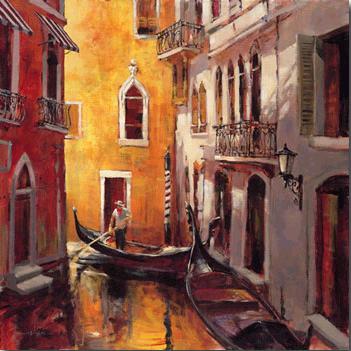


Venice from space
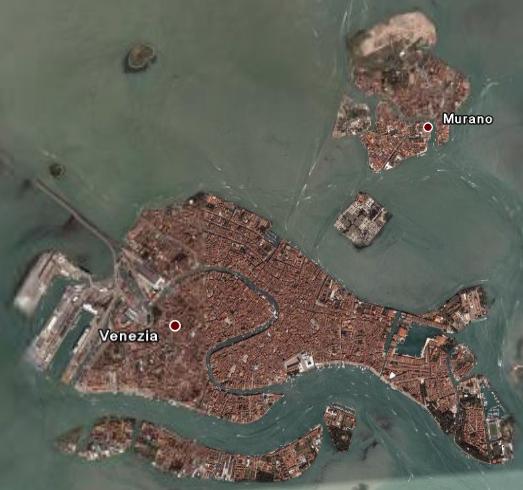
Murano
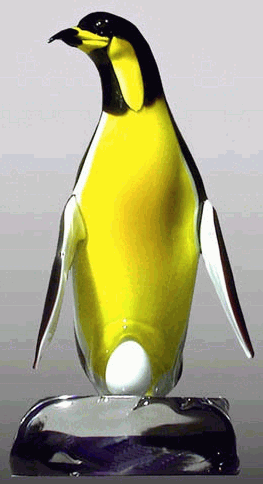

Burano


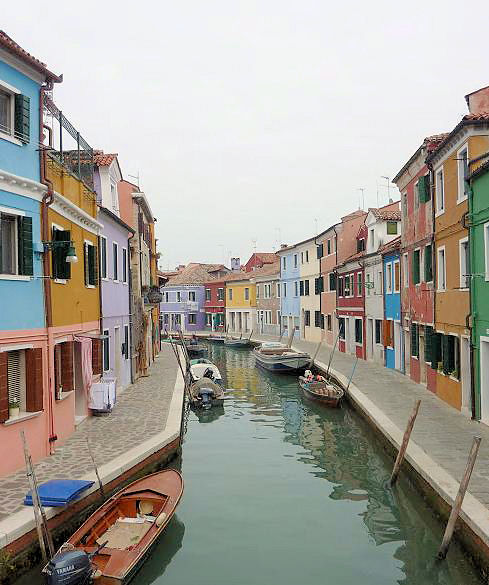

Art and Artists
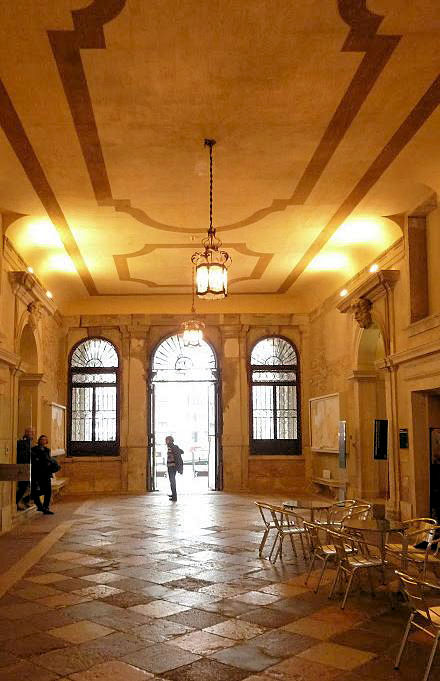
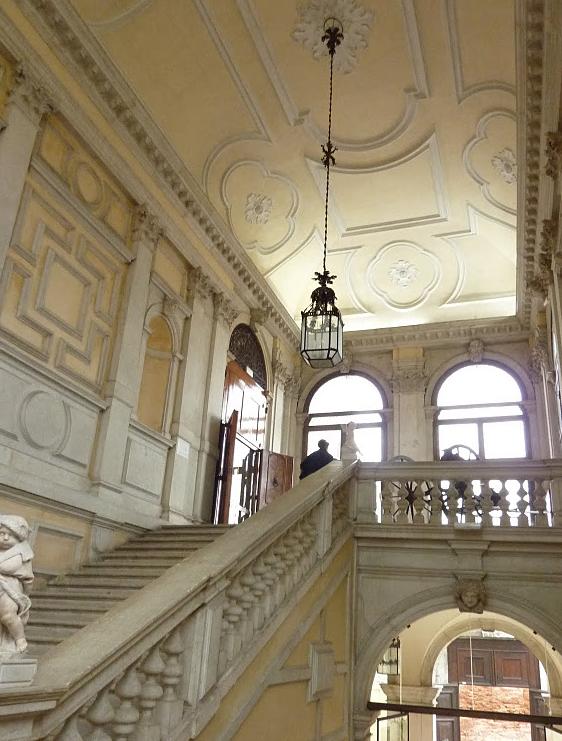
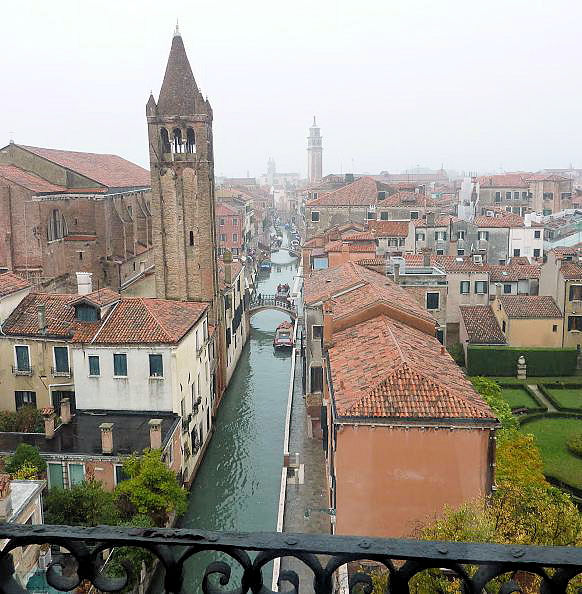
Some Sources for
Venice Info - Hotels...

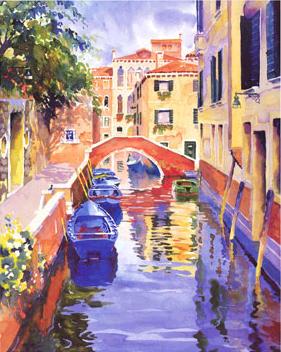
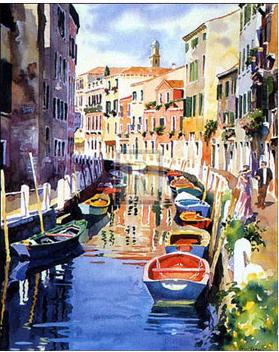
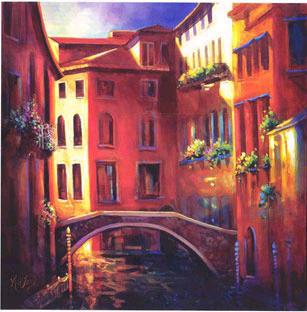

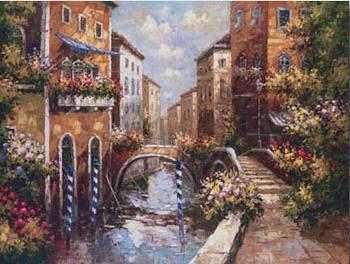
Introduction

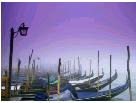
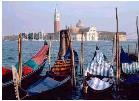
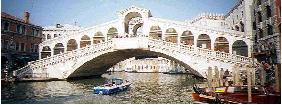

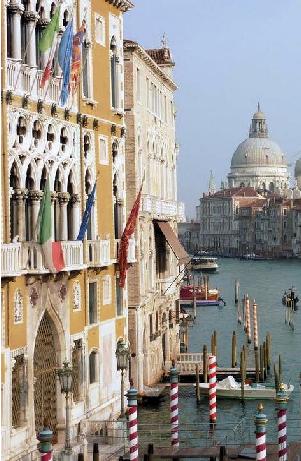
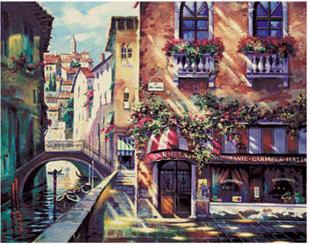
Vaporetti - Boat Busses
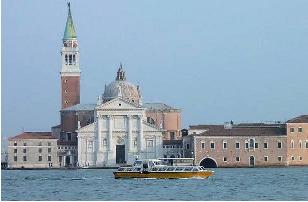
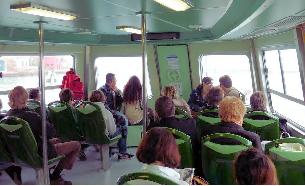
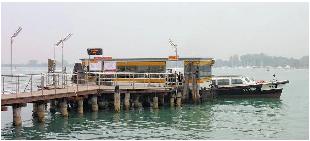
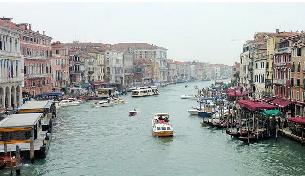


The Local Point of View
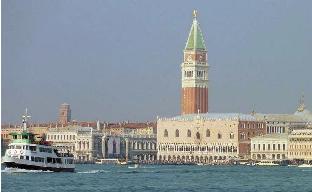
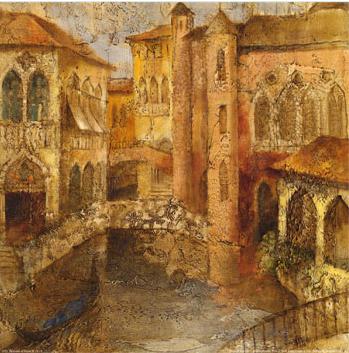
La Fenice
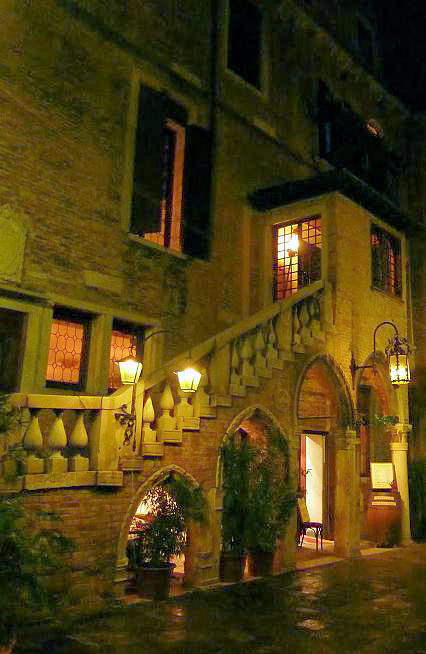
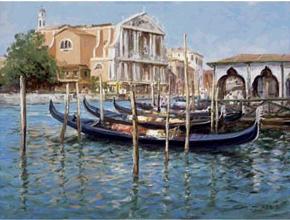
Gondolas
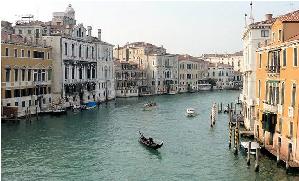
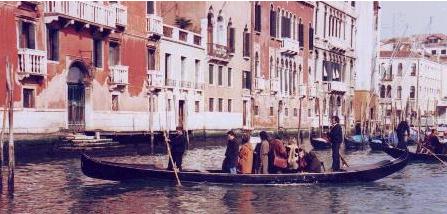
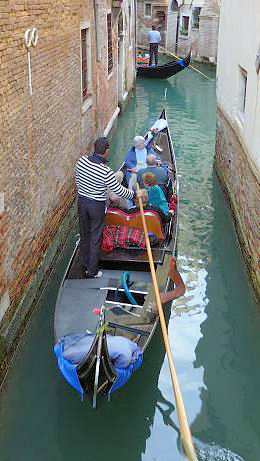
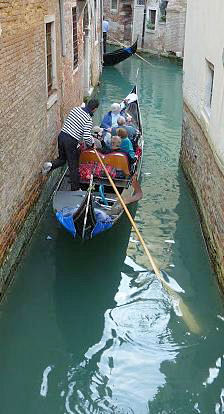
Carnevale



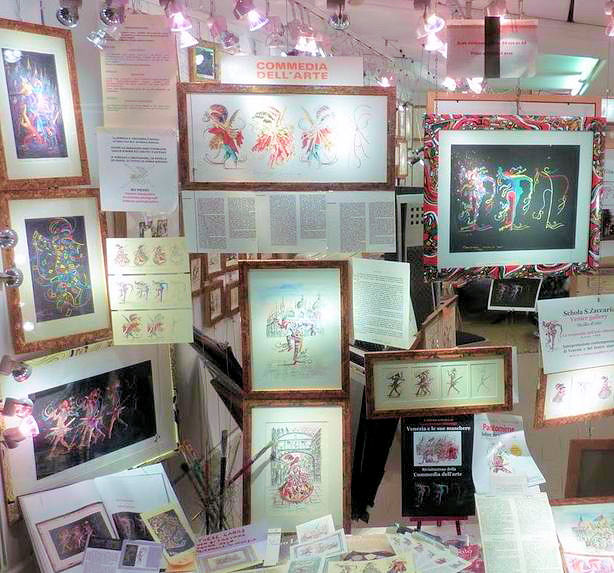
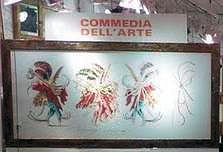
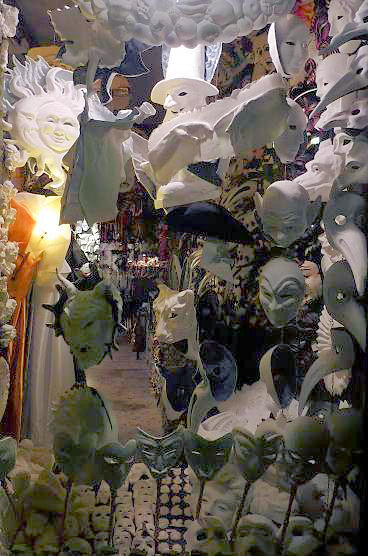
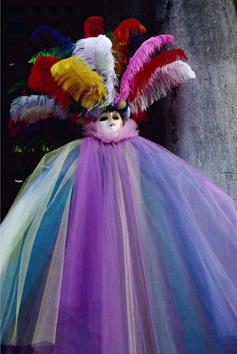
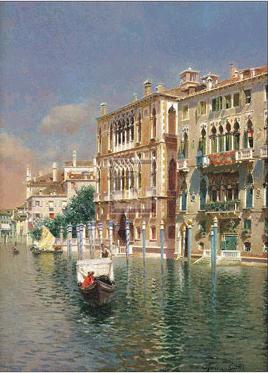
Virtual Tours and Real Tours
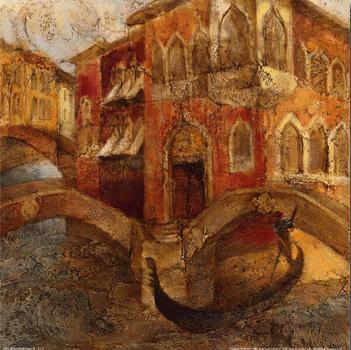
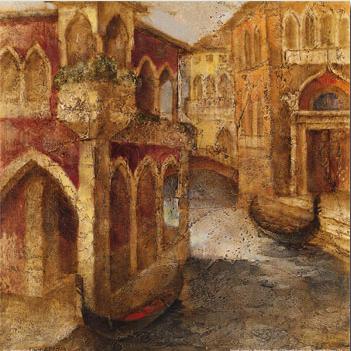
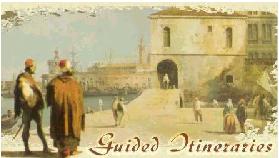




Photochrome Images of Venice Circa 1890
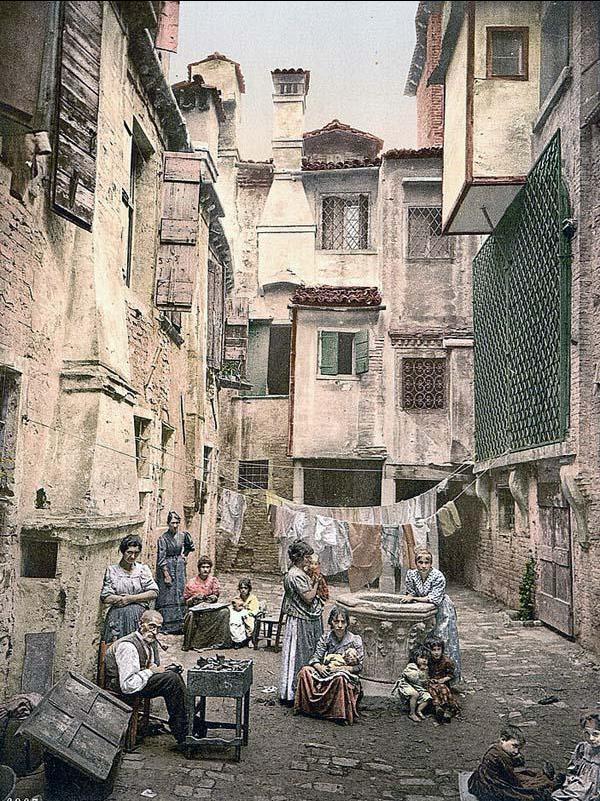
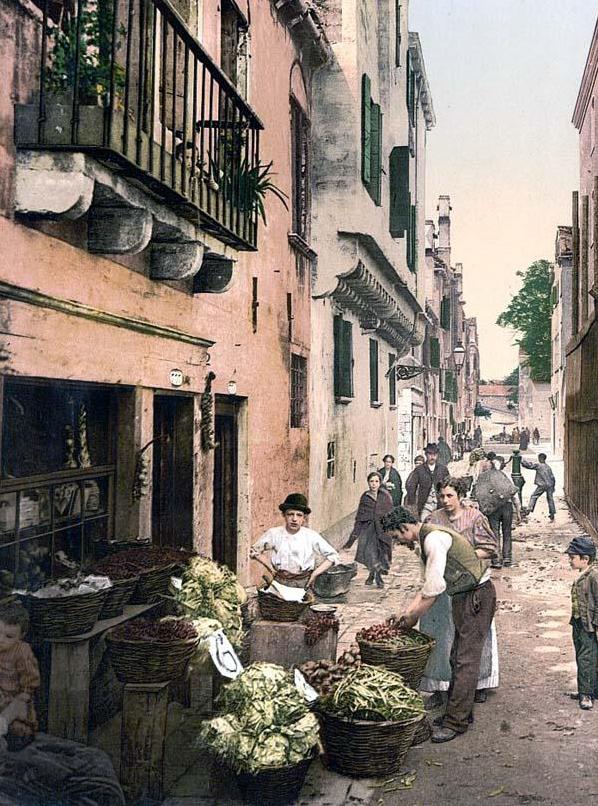
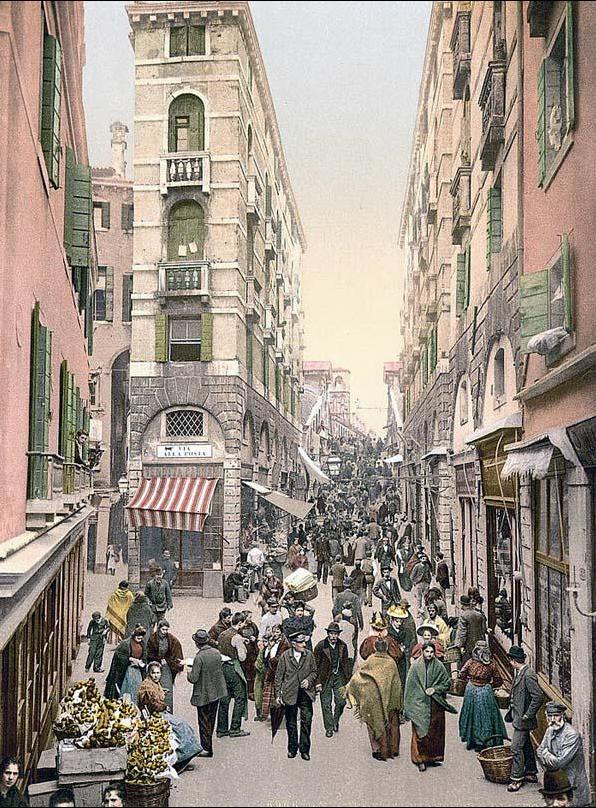
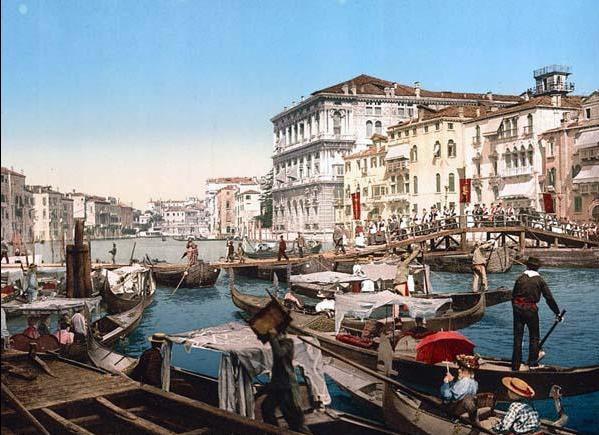

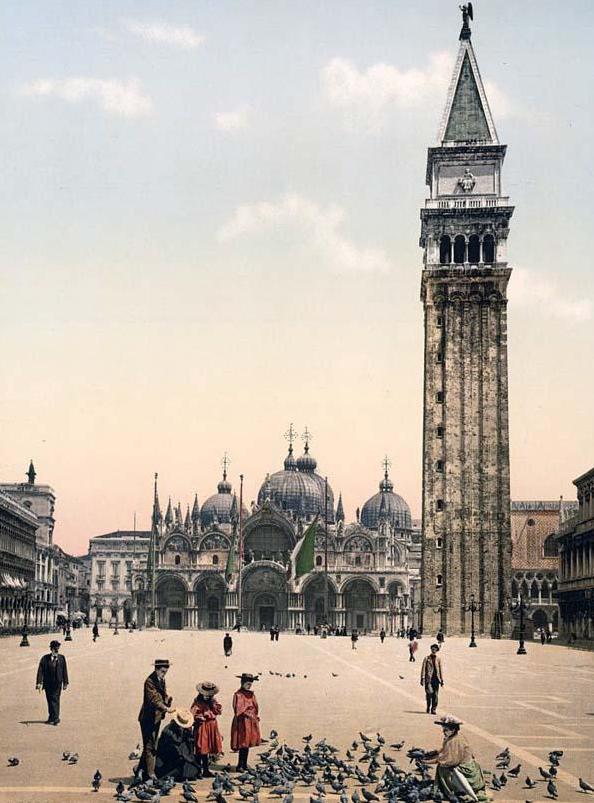
Cesare
Colonnese
Aqua Alta
Books
About Venice